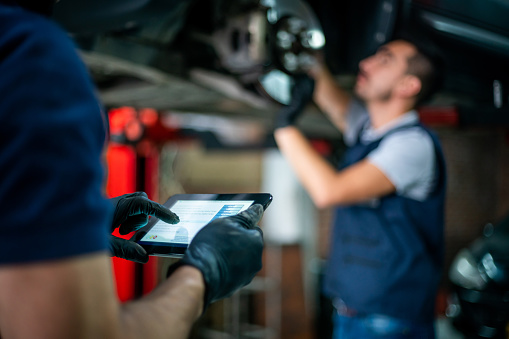March 5, 2025
Auto Maintenance
Auto maintenance refers to the process of regularly inspecting and servicing a vehicle to ensure that it is in good working condition and to prevent potential issues from developing. Proper auto maintenance can help extend the lifespan of a vehicle, improve its safety and reliability, and ultimately save the owner money by reducing the need for costly repairs.
Some common auto maintenance tasks include:
- Regular oil changes
- Checking and maintaining fluid levels (e.g. coolant, brake fluid, power steering fluid)
- Inspecting and replacing air filters, spark plugs, and other engine components
- Rotating tires and checking tire pressure
- Replacing worn brake pads and checking brake fluid levels
- Testing and replacing the car battery if necessary
- Checking and replacing belts and hoses
- Inspecting and replacing windshield wipers and washer fluid
The specific maintenance schedule for a vehicle can vary depending on the make, model, and year of the car, as well as the driving habits and environment of the owner. It’s important to consult the owner’s manual and/or a trusted mechanic to determine the appropriate maintenance schedule for a particular vehicle.

What does auto maintenance do?
- Improving vehicle performance: Regular maintenance tasks such as oil changes, replacing air filters, and checking fluid levels can help keep a vehicle running smoothly and efficiently. This can lead to improved acceleration, better fuel economy, and a more responsive engine.
- Extending the lifespan of a vehicle: By addressing minor issues before they become major problems, auto maintenance can help extend the lifespan of a vehicle. This can save the owner money in the long run by reducing the need for expensive repairs or the premature need for a new vehicle.
- Enhancing safety: Regular maintenance can help identify and fix potential safety issues such as worn brake pads, tire wear, or a malfunctioning battery. This can help reduce the risk of accidents or breakdowns on the road.
- Maintaining resale value: A well-maintained vehicle is generally worth more than one that has been neglected. By keeping up with regular maintenance tasks, owners can help maintain the resale value of their vehicle.
Overall, auto maintenance is an important aspect of owning a vehicle. By staying on top of regular maintenance tasks, owners can help ensure that their vehicle runs smoothly, safely, and reliably for years to come.
What is an example of auto maintenance?
Auto maintenance includes a variety of tasks that help keep a vehicle running smoothly and prevent breakdowns. Here’s an example:
Changing the oil – Regular oil changes are crucial for maintaining the engine’s health. Oil lubricates the engine parts, reducing friction and wear. Most vehicles need an oil change every 3,000 to 7,500 miles, depending on the type of oil used and the vehicle’s make and model.
Other examples of auto maintenance include checking tire pressure, replacing air filters, rotating tires, and checking fluid levels (like coolant, brake fluid, and transmission fluid).
What is the most basic maintenance for a car?
- Checking and maintaining fluid levels: This includes checking the engine oil level, coolant level, brake fluid level, power steering fluid level, and transmission fluid level (if applicable). Low fluid levels can cause damage to the engine or other vehicle components, so it’s important to keep them at the recommended levels.
- Checking tire pressure: Tires that are underinflated or overinflated can affect vehicle handling, fuel economy, and tire wear. It’s important to check the tire pressure regularly (at least once a month) and inflate the tires to the recommended pressure listed in the owner’s manual or on the tire placard.
- Replacing worn wiper blades: Wiper blades that are worn or cracked can reduce visibility and safety when driving in inclement weather. It’s important to replace them at the first sign of wear.
- Inspecting and replacing air filters: The air filter is an essential component of the engine that helps to prevent dirt and debris from entering the engine. A dirty air filter can reduce engine performance and fuel economy, so it’s important to inspect and replace it at the recommended intervals.
- Regularly washing the car: Regular washing and waxing of the car can help to protect the paint and prevent rust. It also helps to keep the car looking good and can contribute to a higher resale value.
These are some of the most basic maintenance tasks that vehicle owners can perform themselves. However, it’s important to refer to the owner’s manual for specific maintenance requirements for the particular make, model, and year of the vehicle.
What are the 5 types of maintenance?
- Preventive maintenance: This type of maintenance involves performing routine tasks such as oil changes, fluid checks, and tire rotations at regular intervals to prevent problems from occurring.
- Predictive maintenance: This type of maintenance uses data analysis and technology to predict when a component is likely to fail and proactively replace or repair it before it fails.
- Corrective maintenance: This type of maintenance involves fixing a problem that has already occurred, such as replacing a worn-out brake pad or repairing a broken component.
- Condition-based maintenance: This type of maintenance involves monitoring the condition of specific components and performing maintenance tasks based on their current condition, rather than a set schedule. For example, replacing a timing belt based on its wear and tear rather than a set mileage interval.
- Reactive maintenance: This type of maintenance involves reacting to a problem that has occurred, such as a flat tire or dead battery, and addressing it as quickly as possible to get the vehicle back on the road.
Each of these types of maintenance is important for keeping a vehicle running smoothly and safely. By performing the appropriate maintenance tasks at the right time, owners can help prevent breakdowns and prolong the life of their vehicle.
